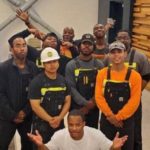By Messiah Fagerholm
It is no secret that most public schools don’t fund art classes and programs as much as other programs. Even Rainier Beach’s Paul Robeson theater goes mostly unused for theatrical plays. Great artists are needed and sought after more than ever! From animators to painters; From photography to theater, the need for creative thinkers is needed. So it’s good to know that there are some programs out there to help teach these young artists in a more new and dynamic way.
I recently got to do an interview with Dante Felder, one of the program directors for South End Stories. He told me about how South End Stories has a mission of teaching the youth of Seattle in theatrical arts and film. And then using that to help teach other subjects in a more entertaining way. But rather than sitting down and learning about history “Were able to get dirty. People are doing reenactments”, “Bringing things to life Rosa Parks, or Martin Luthur King, or Malcom X, some of our historic giants. Making it useful and again palpable, for our students to say ‘huh, my history is not dead. It’s alive’. That’s what we do with arts, we make it alive and exciting for students.”
But making education more palpable and entertaining is only one part of the equation. How do you make teaching art different? How do you make it truly dynamic? It turns out it’s not about teaching a curriculum step by step, and not about just being a teacher. “My role should be a facilitator. Creating a space where students start more dependent, they need to learn these things, get these concepts down so that they can work their way to interdependence. That’s when they’re sometimes leading, sometimes learning, sometimes they’re growing, sometimes they’re shrinking.”
So you can see, teaching different forms of art dynamically has a few different layers to it. Not only is it about being able to teach different subjects in a way that catches students attention and being able to bring those lessons to life. It’s also about having this system that is flexible enough to give students the chance to teach others and learn from others when needed. And of course this only scratches the surface of what makes the South End Stories program unique. If you want an even deeper understanding of how SES works and who Dante Felder is, you can always hear from Dante himself in the podcast interview that we recorded, or take a look at the SES website.
South End Stories: South End Stories website
RBACast: Teaching Art and How it’s Done with Donte Felder





